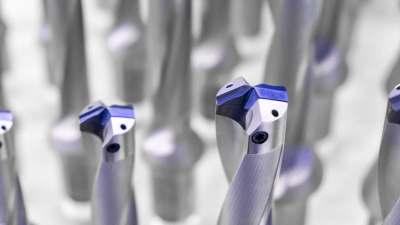What Is a Carbide Drill?

Carbide drills are mainly used on milling machines and drilling machines. They are mainly used to drill holes in hard materials or materials that are difficult to drill. One of the characteristics of cemented carbide is that it is extremely hard.
Cemented carbide is an alloy made by sintering hard metal carbide powder with iron-based metal powder. The shape of the blade portion can be varied, but those with a double-edged spiral shape are generally used.
Uses of Carbide Drills
Uses of cemented carbide drills have advantages and disadvantages:
- Advantages: Compared to HSS, the extremely high hardness of cemented carbide drills enables high-speed cutting and shortens machining time. Also, the inflexible and very rigid nature of HSS prevents bending and enlargement of holes, enabling accurate machining.
- Disadvantages: Carbide drills are less resistant to strength loss than HSS, so drill surface defects are more likely to occur.
Principles of Carbide Drills
Carbide drills are used to drill holes in materials that are difficult to machine. “Carbide” (cemented carbide) in carbide drills is an alloy made by sintering a very hard, hard metallic carbide powder with an iron-based metallic powder. It is extremely hard, with a longitudinal modulus of elasticity three times that of iron and an indentation hardness of around 90.
Carbide drills are harder than HSS, the base metal, and therefore can be used for high-speed drilling. Carbide drills are also suitable for precision drilling due to their inflexible and extremely rigid nature. In addition, in order to use carbide drills correctly, it is necessary to confirm in advance the machining process that is suitable for the cutting conditions depending on the diameter and type of drill and the material to be cut, and to perform the machining. Since it is possible to use the drill again by re-coating and polishing, it is recommended to use the drill again. Although each piece is more expensive than HSS, the tool life is longer and the final cost is lower than that of HSS.
Disadvantages of Carbide Drills
Carbide drills are harder and more heat-resistant than HSS drills, so they can drill through difficult-to-cut materials such as titanium and stainless steel, and their high durability gives them a long service life. On the other hand, one of the disadvantages of this drill is that its high hardness makes it less tough and prone to cracking and chipping (chipping) due to brittle fracture. Chipping and breakage can occur when the shank (the part of the handle without a blade attached) slips because the holding power of the tool is weakened. Another disadvantage is that the initial purchase cost is higher than that of HSS drills because tungsten used in cemented carbide is a rare metal and extremely expensive. On the other hand, since it can cut at high speeds and has an even longer service life, the running cost is lower, which may result in lower total cost.
Cutting Stainless Steel With Carbide Drills
Since stainless steel is harder and more tenacious than common steel, Carbide drills, which are harder than HSS drills, are used. Carbide drills for stainless steel are not only made of different materials, but also have a cutting edge angle of 135 degrees, higher than the 118 degrees of HSS drills, to reduce contact resistance during cutting. The core thickness is also made thinner to reduce resistance.
Breaking of Carbide Drills
Carbide drills are harder than HSS drills, but their toughness is inferior. Causes of breakage include “increased cutting resistance,” “seizure and softening,” and “tilting.” The deeper the cutting hole, the harder it is for the cutting fluid, which serves as cooling and lubrication, to reach the drill, and the more likely it is that the drill and workpiece will seize. In addition to this, the temperature rises due to frictional heat, which softens the drill itself, making it easier to break. When the hole is deep, cutting debris cannot be discharged properly and gets stuck, which also causes increased cutting resistance. Another cause of breakage is the shear force exerted on the drill by an inexperienced operator who tilts the drill in the middle of cutting. Drills are strong against longitudinal forces but weak against shear lateral forces, so care must be taken in cutting conditions.